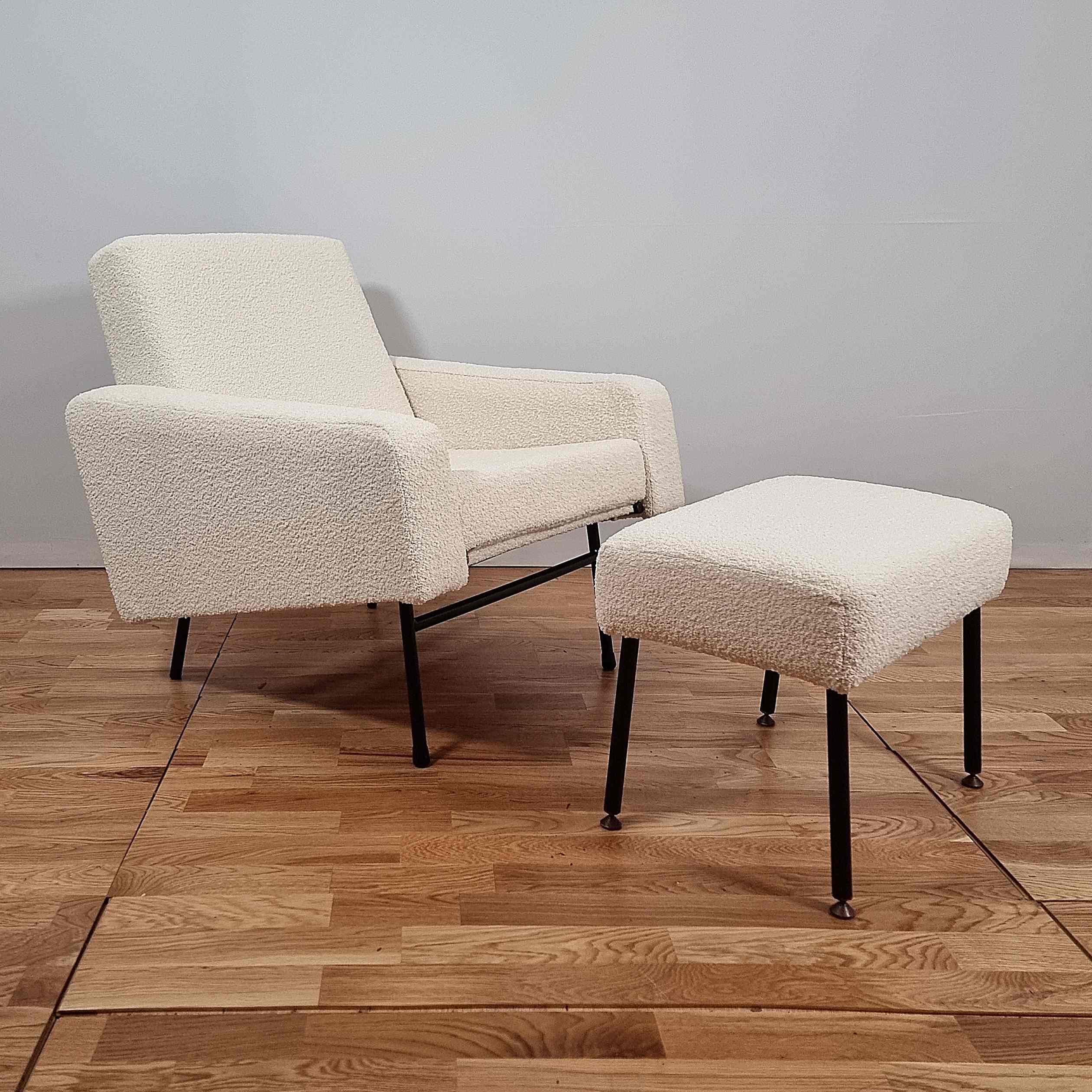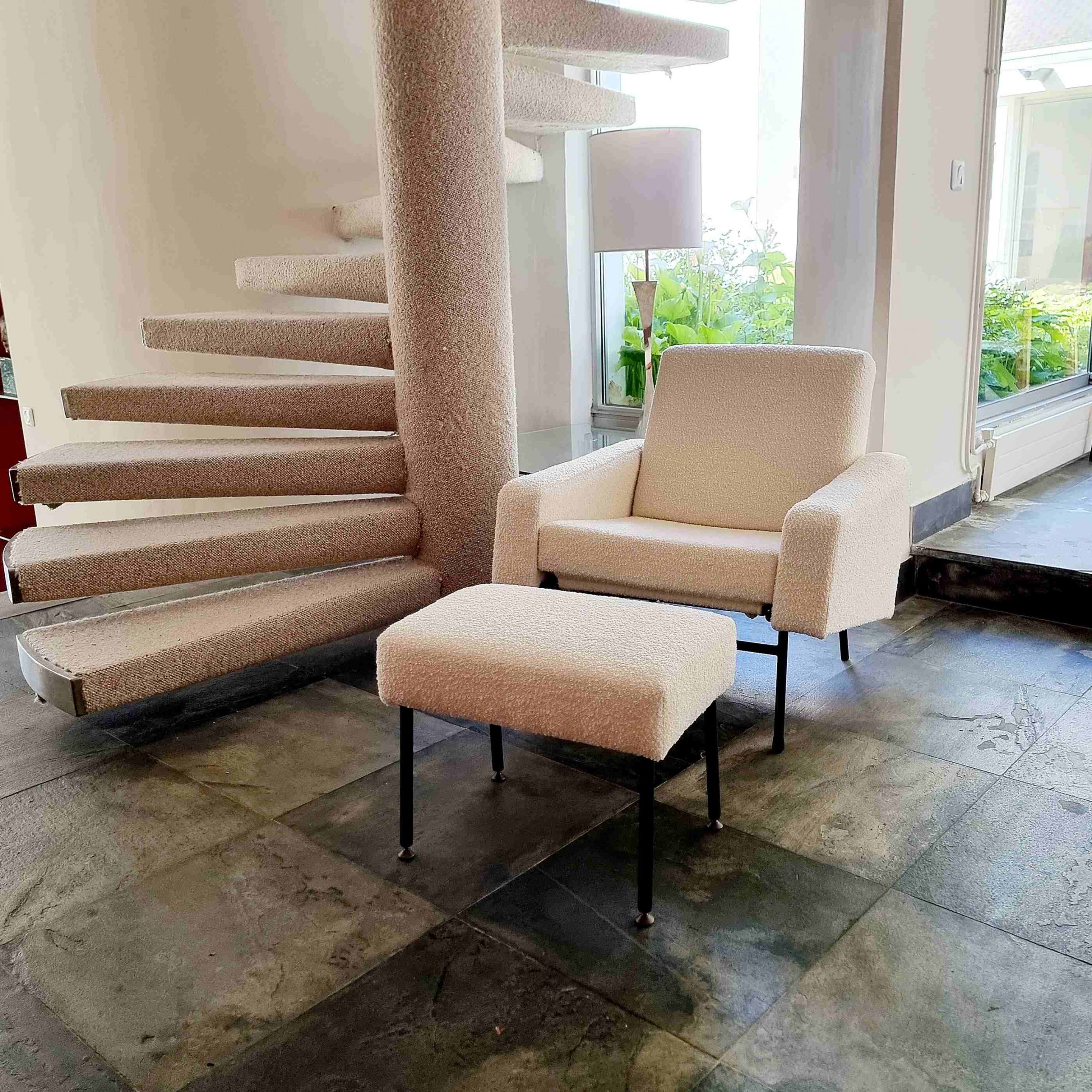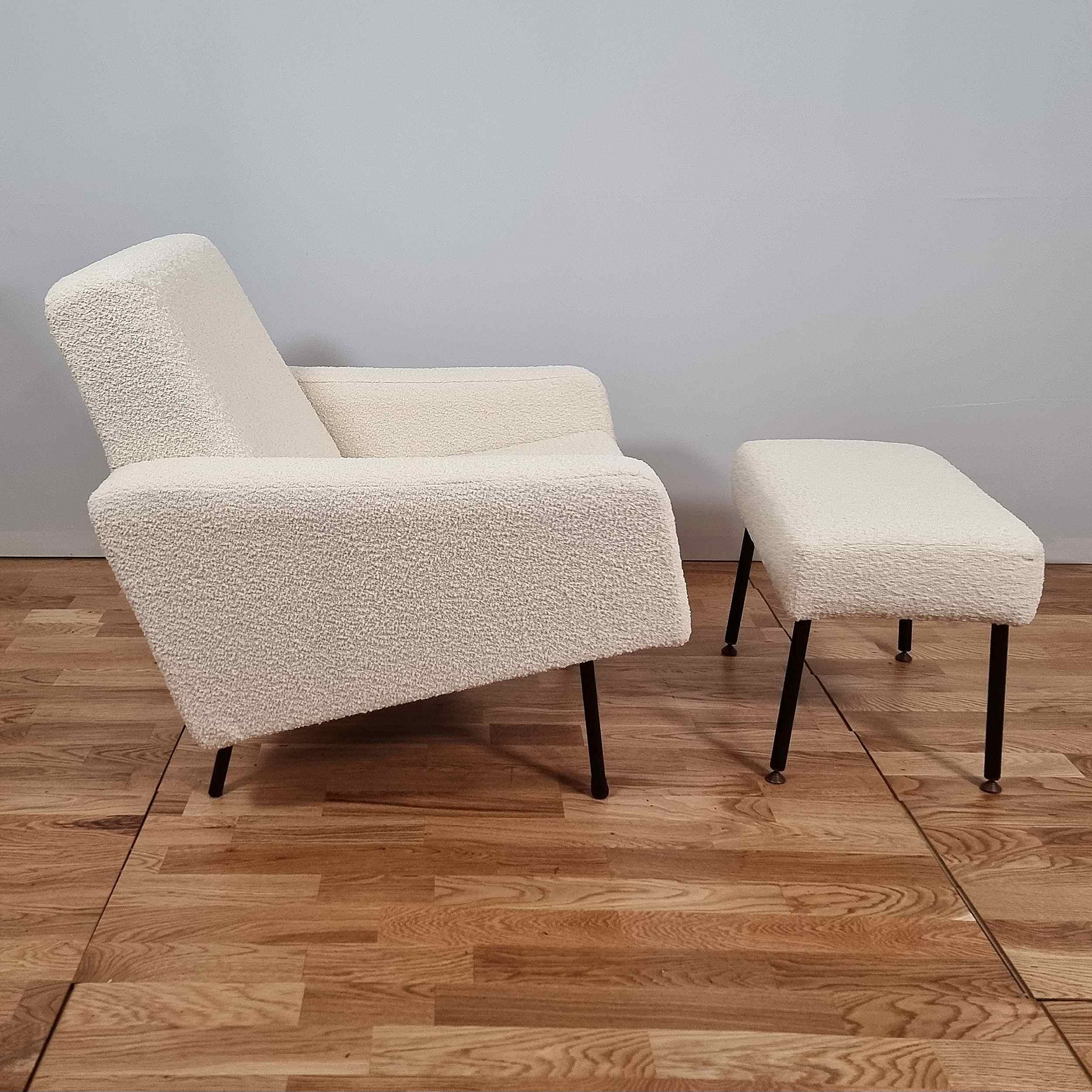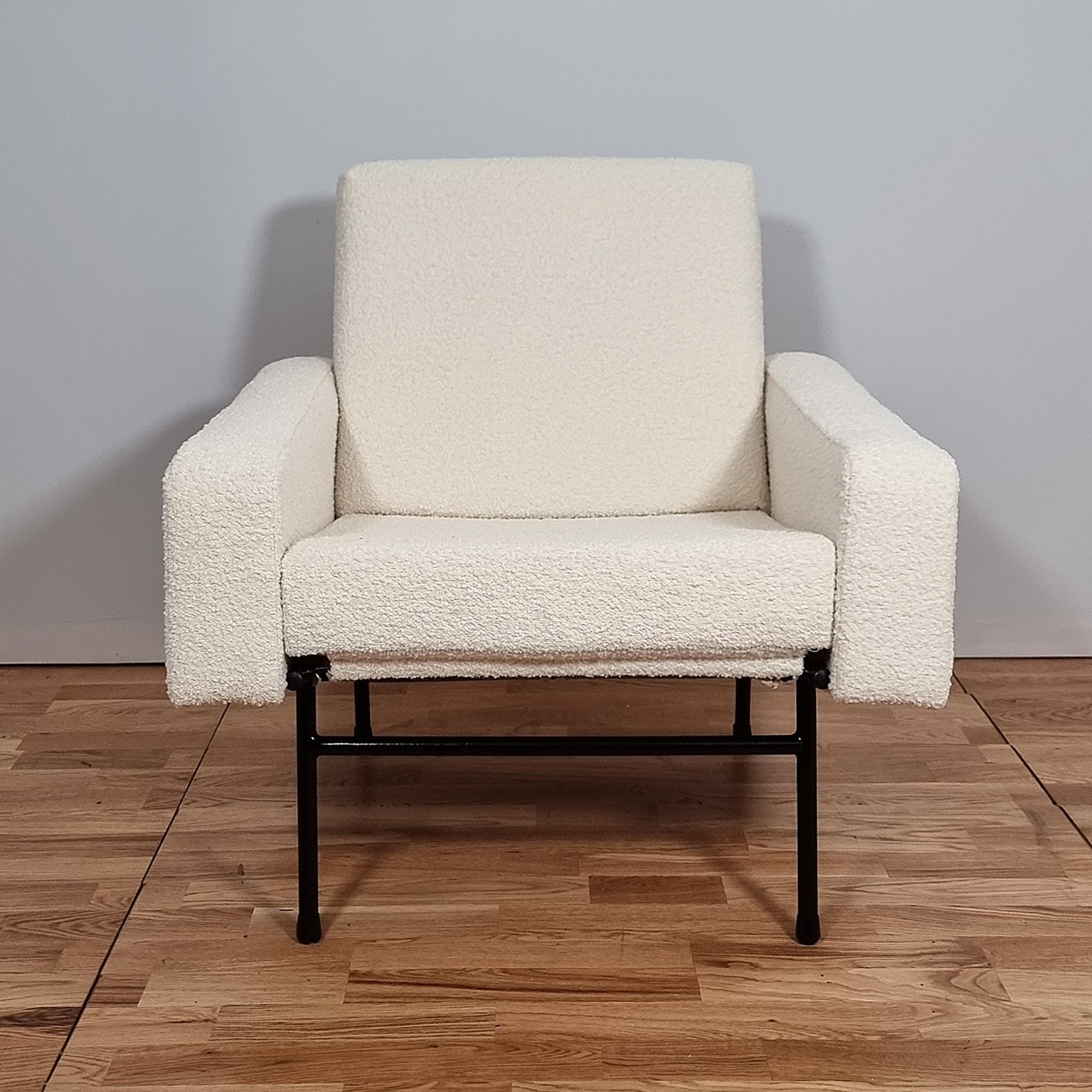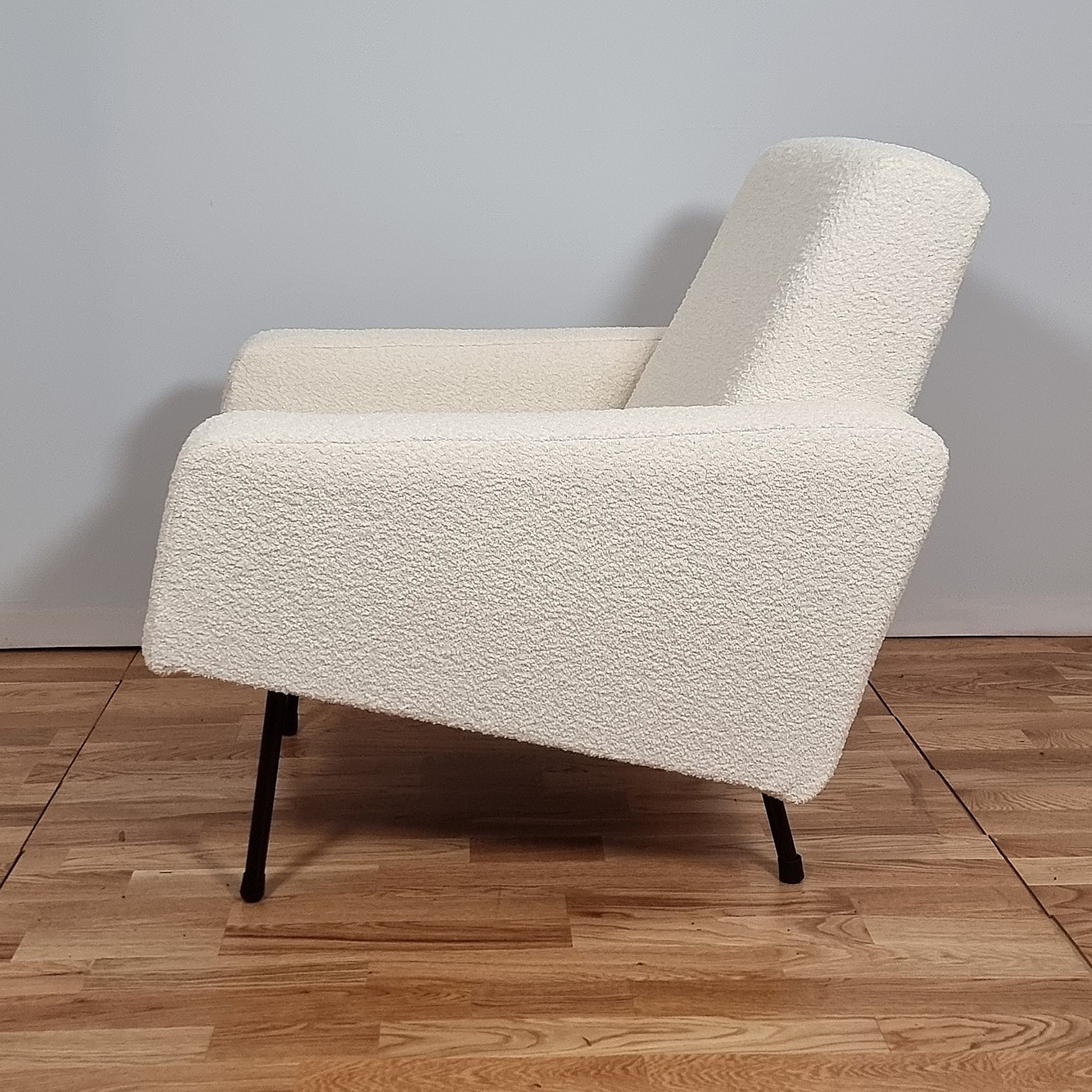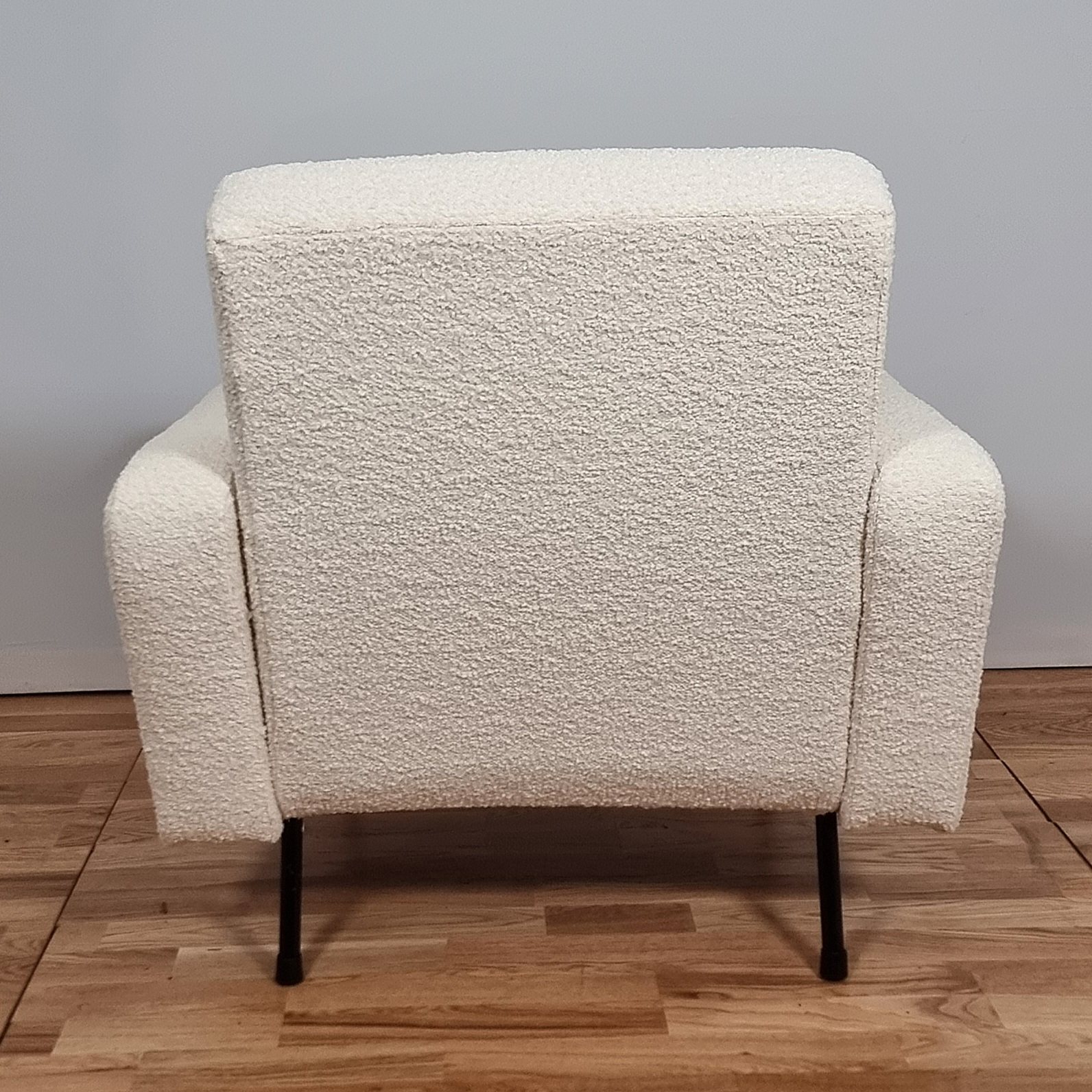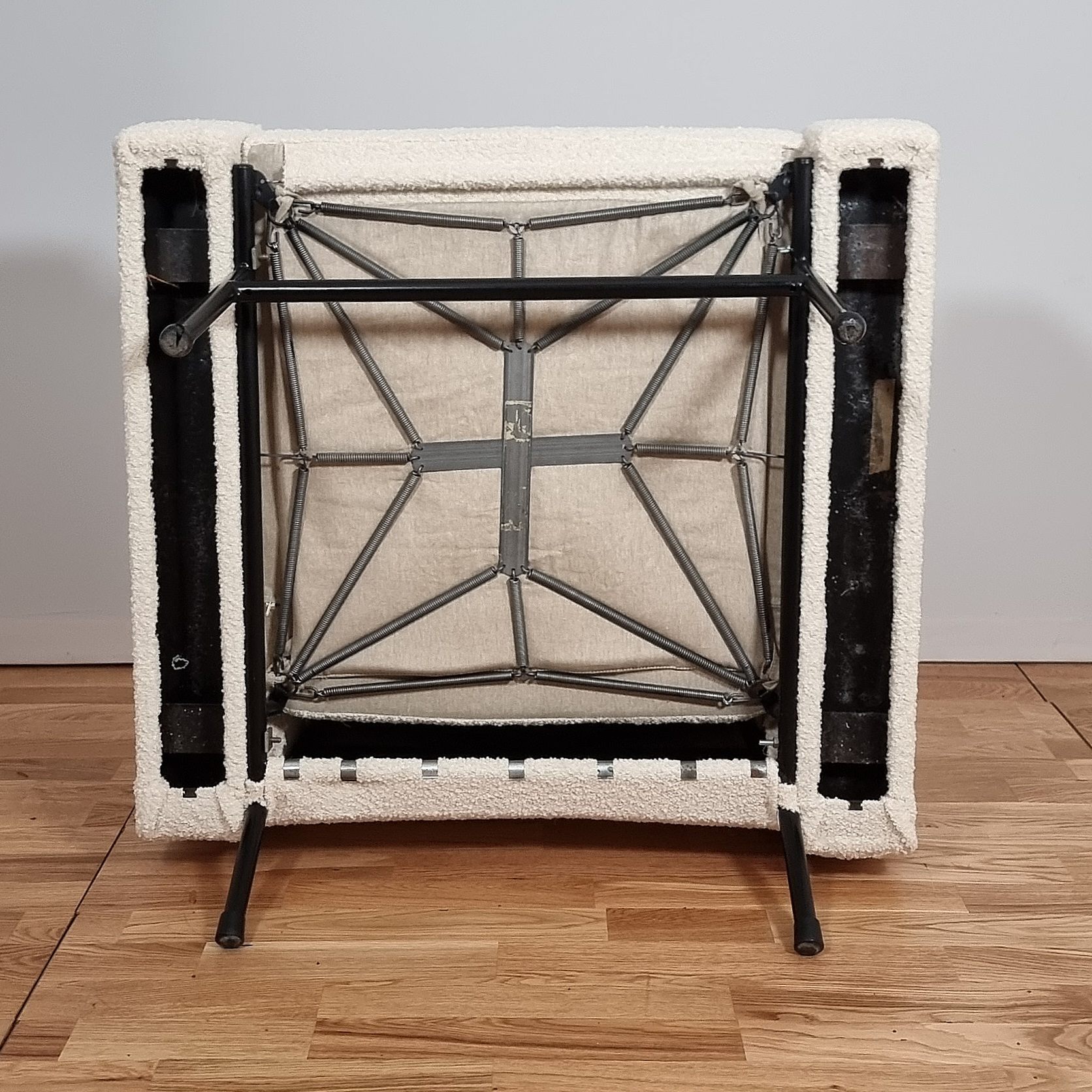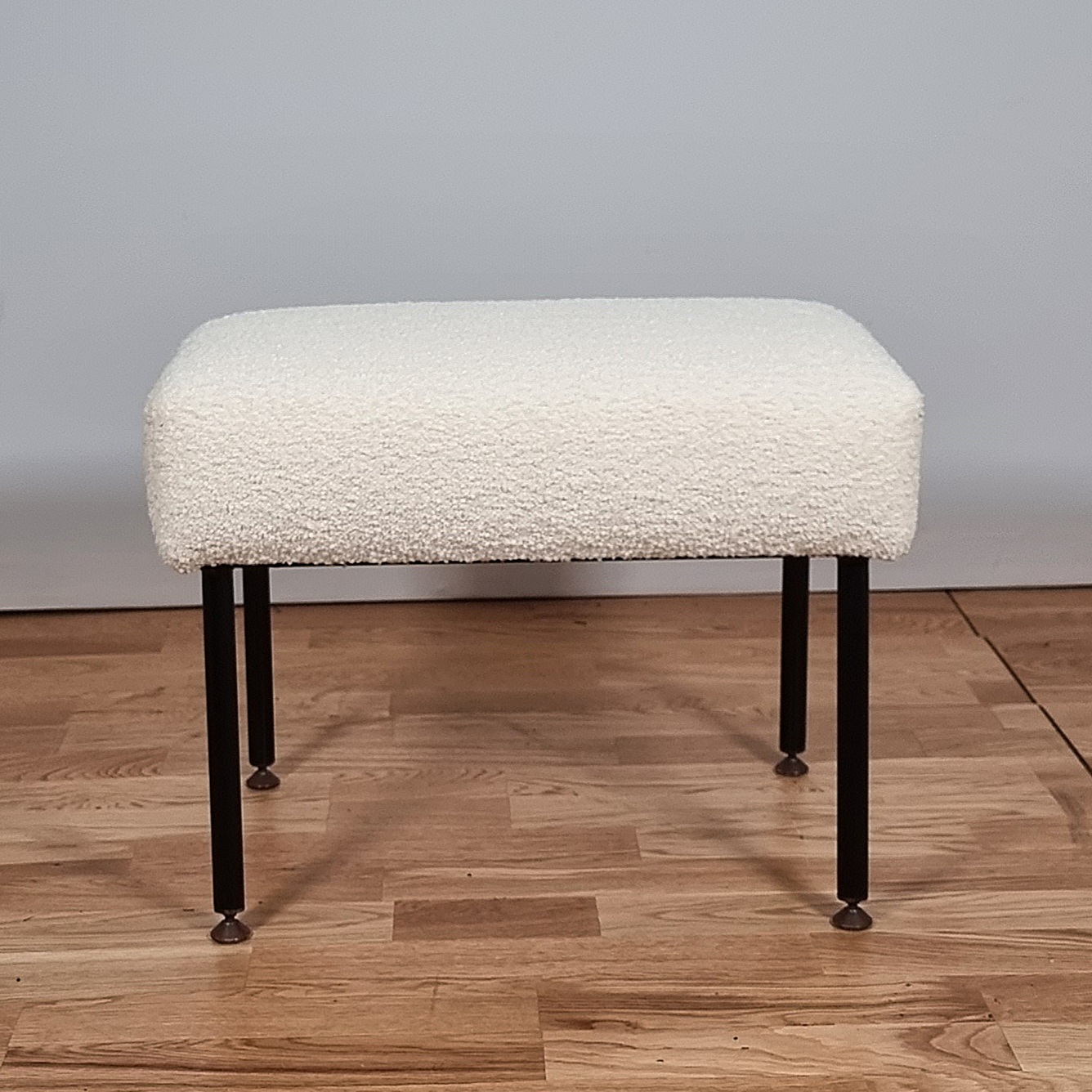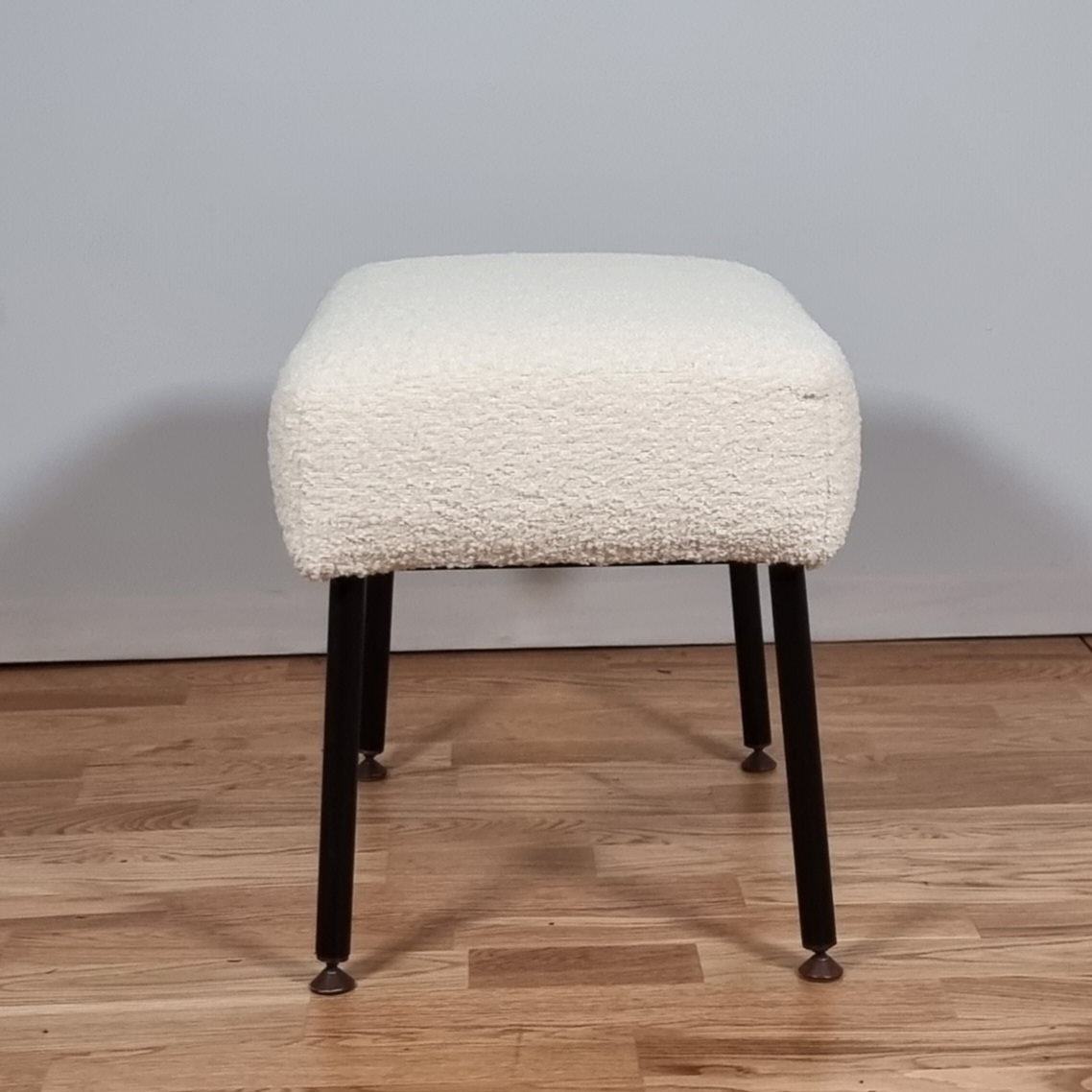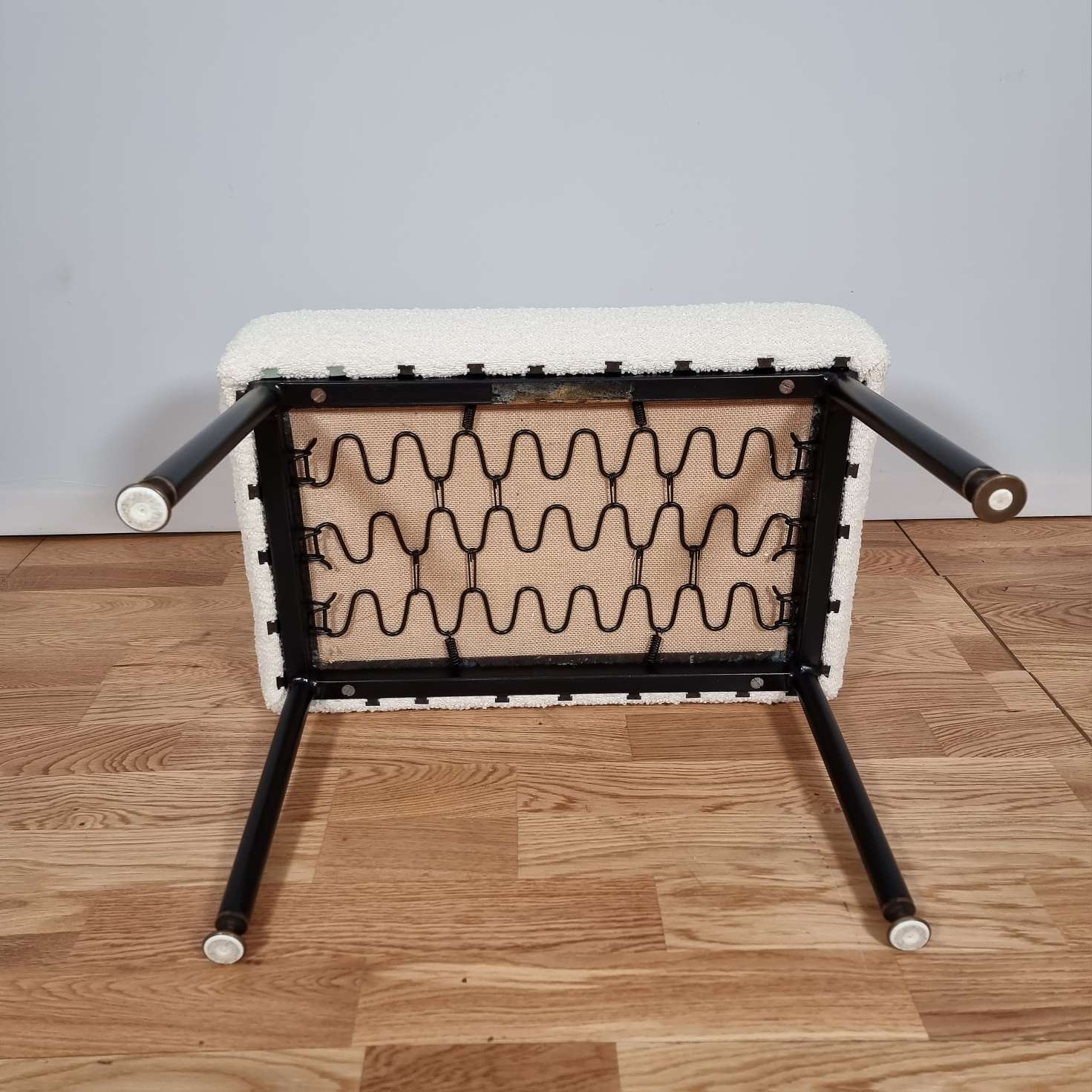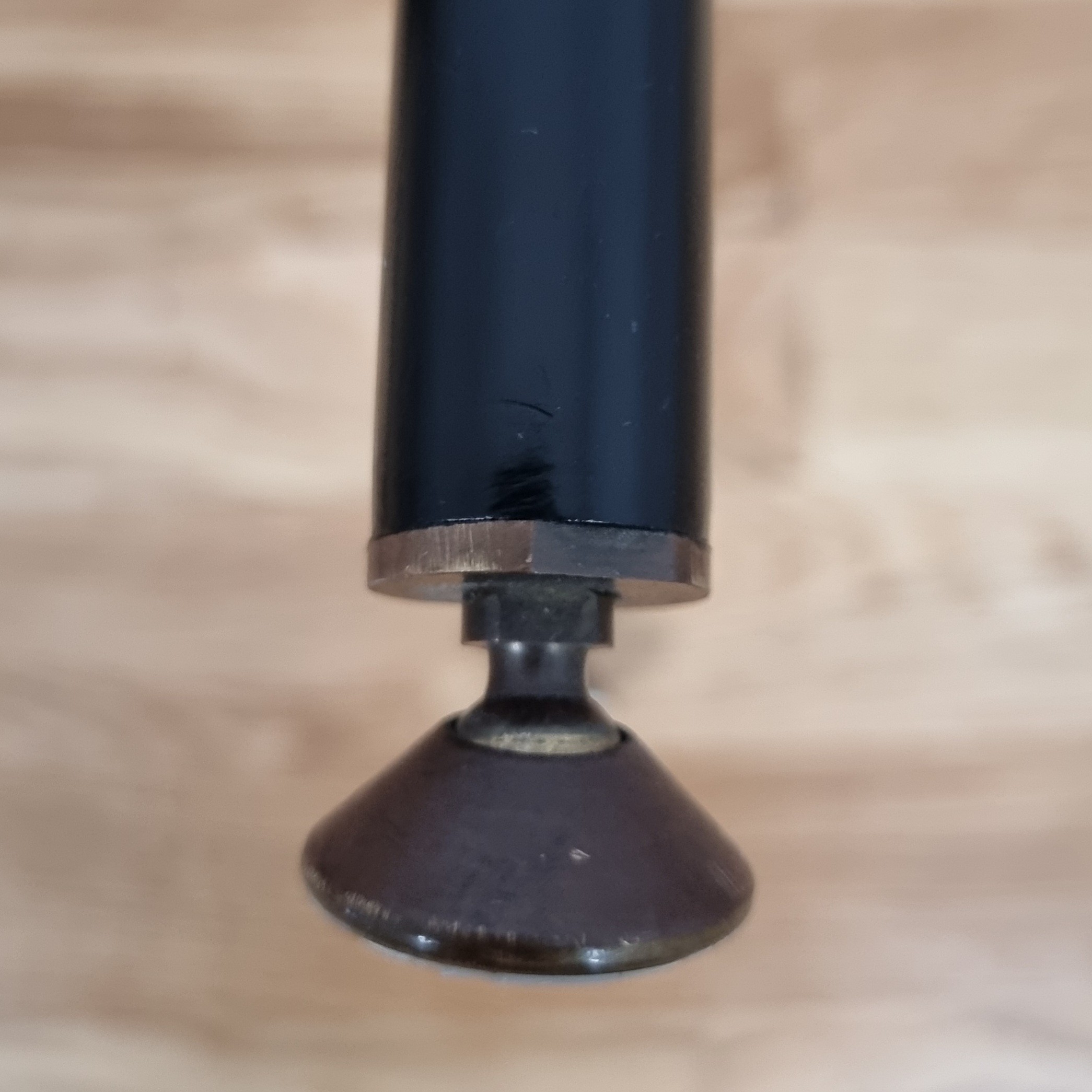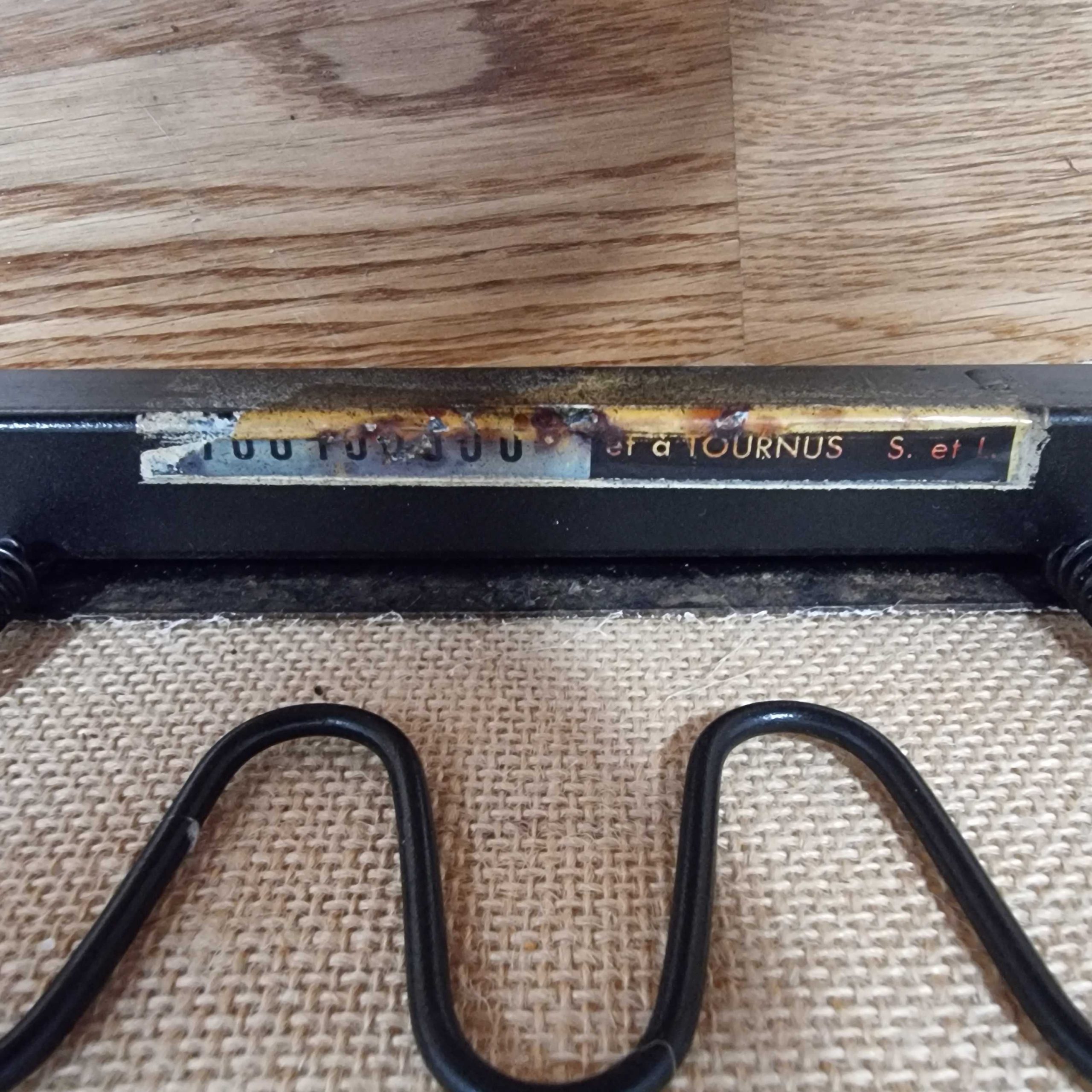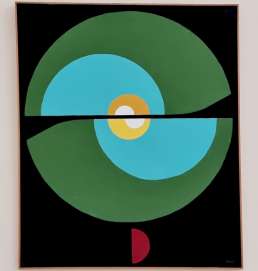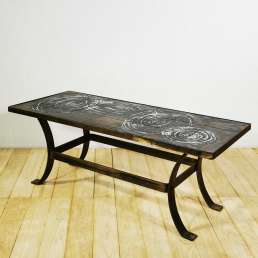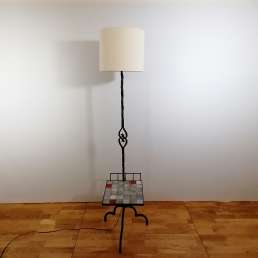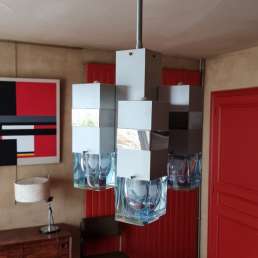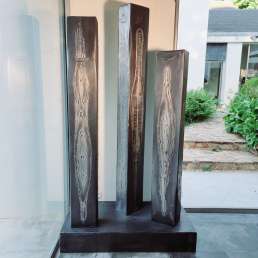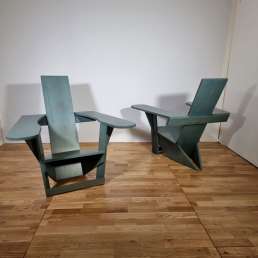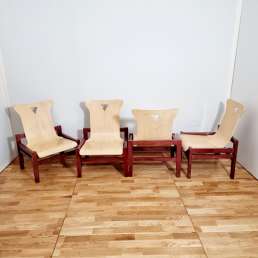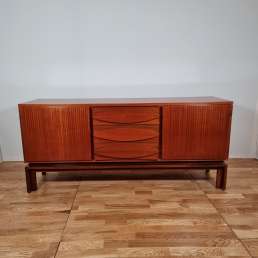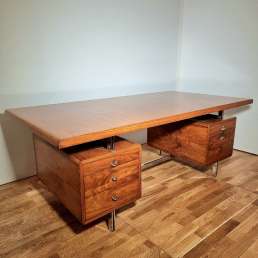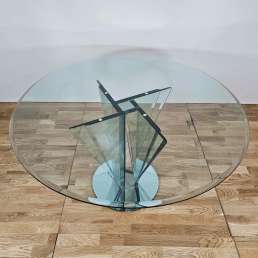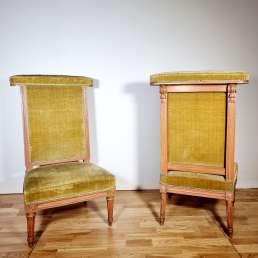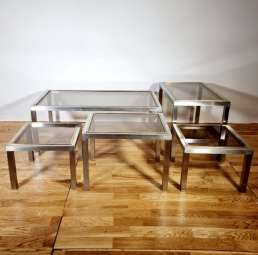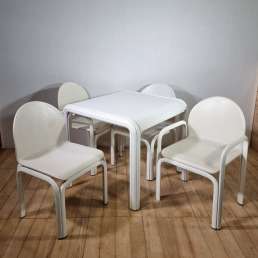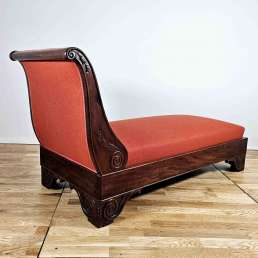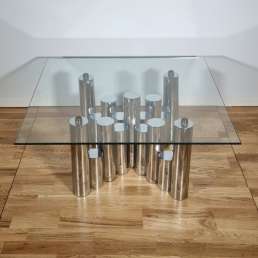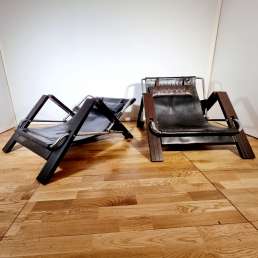Sold – Pierre Guariche for Airborne, G10 armchair and Troika ottoman, circa 1955
Description
What I like
I really like this set made up of Pierre Guariche’s G10 armchair and the Troika ottoman designed by Paul Geoffroy, which are icons of the 1950s/1960s.
The very geometric shapes of the backrest and the low seat, and above all the characteristic inclination of the two blocks forming the armrests, drawing an elegant trapezium, combined with their minimalist metal base, make the armchair supremely elegant. The Free-span seat system developed by Airborne in metal plates and springs ensures great comfort, relayed by the foam of the backrest and seat. Finally, the ottoman by the same designer, for Airborne, with the same taut lines, allows you to lengthen the legs, for maximum comfort.
To bring out the very taut lines of their design, an off-white bouclé fabric by Bisson Bruneel, the Rolls of fabrics, was chosen, which follows the edges of these very clean volumes as closely as possible. The off-white gives them a clean, very modern look.
I really like the fact that this armchair and this ottoman were designed by Pierre Guariche and Paul Geoffroy, two of the great French designers of the 1950s/1960s and were produced by Airborne, which, having made great profits with the AA armchairs, can develop collaborations with the greatest: Guariche, Olivier Mourgue, René-Jean Caillette… Their use of the Free-span seat system introduces comfort and great purity of line, thanks to the thinness of the seat that this allows.
Technical description
Pierre Guariche (1926-1995) and Paul Geoffroy designers-Airborne editor
G10 armchair, the model created in 1955 by Pierre Guariche and Troika ottoman, created during the same period by Paul Geoffroy.
The armchair is composed of a tubular base in black lacquered metal, supporting four oblique legs connected at the front and at the back by a spacer and finished with black plastic glides, a seat, a backrest, the two rectangular ones, and two trapezoidal foam armrests covered with an off-white Bisson Bruneel wool and cotton terry fabric. The very comfortable armchair thanks to the system of springs and Free-span slats which supports the seat and allows it to be very thin.
The ottoman with rectangular seat has four slightly oblique legs in black lacquered metal, small brass feet.
Completely restored and reupholstered according to the original model, new foams and fabric.
Remains of the manufacturer label on the ottoman.
Bibliography: L. Blaisse, A. Jacob, A. Jeauneau, Pierre Guariche, Norma editions, model reproduced p. 100, for the G10 armchair. Pierre Deligny, Galerie les Modernistes edition, Airborne: the drawing with rating of the Troika fireside chair appears in the adjoining booklet: Index of models 1945-1975.
Dimensions and weight
Armchair:
Height: 77 cm – Width: 75 cm – Depth: 79 cm
Seat height: 39 cm
Weight: 18.5kg
Ottoman:
Height: 41 cm- Width: 53 cm- Depth: 34,5 cm
Weight: 7 kg
Mix & Match
This G10 armchair and the Troika ottoman have a great purity of line, as well as a great lightness. As a result, they lend themselves quite well to many cohabitations!
Contemporary with the tablet floor lamp by Mado Jolain and René Legrand, the gray and orange of the tablet playing with the more neutral off-white of the armchair and its ottoman, they can also dialogue with the coffee table by Julien de Covemaeker at the bronze ceramic top.
I imagine them to be a counterpoint of whiteness to the important sculpture by Guillaume Leunens “Colonnes”, dated 1966, whose surface worked in matte metal also stretches straight lines in space.
To stay in a chic but modern atmosphere, the Cubico chandelier by Gaetano Sciolari can light up the room where they will be placed. There is the same search for simplicity but also for refinement of line and details.
On the walls, we have a choice: everything goes very well with our G10 armchair and the Troika ottoman, which have a neutral color and a very refined design!
Obviously, as a first choice, I will hang the Composition of Edgard Pillet, which dates from the years 1950/1951 and has the same requirement of extreme rigor of the lines without however neglecting the beauty of the chromatic range.
Each of the two tapestries by Daniel de Linière Vent d’été and Nuit d’Espagne will play its game differently with this set by Pierre Guariche and Paul Geoffroy: Vent d’été is completely contemporary, and its decoration cut out on this beige background will work perfectly. next to the clean off-white of the armchair and the ottoman. The large flat areas of Nuit d’Espagne will match the more neutral palette of our armchair and its ottoman!
Interestingly, you will find other armchairs, both French and American: Charles & Ray Eames, Florence Knoll, Harry Bertoia… similarly design metal legs, which resonate with our set by Pierre Guariche and Paul Geoffroy.
Description
To know more
The designers
Born in 1926 in Paris, Pierre Guariche studied at the National School of Decorative Arts. After the Second World War, he joined forces with a group of young French designers looking for a modern alternative to traditional French decorative arts. Between 1953 and 1057, he collaborated with Joseph-André Motte and Michel Mortier under the acronym ARP (Atelier des Recherches Plastiques) and designed furniture in innovative materials and shapes. At the same time, he began to work for major design companies, such as Airborne, Meubles TV, Hûchers-Minvielle, Disderot and Steiner. At the end of the 1950s, Pierre Guariche became the chief designer of the Belgian company Meurop, where he concentrated on the development of elegant and inexpensive furniture.
Pierre Guariche works as an architect, and designs private, commercial and public residences, including ski resorts. Its designs represent its commitment to simplicity, and exploiting the potential of industrial production without sacrificing quality.
An important figure in the creation of furniture in France around 1960, Paul Geoffroy is unjustly forgotten today. However, his name appears regularly at the time in decoration magazines as well as in Bobois and Airborne commercial catalogs. Indeed, his furniture creations were produced by Bobois, his chairs were produced by Airborne and widely distributed by the Bobois and then Roche-Bobois store network.
The editor
Airborne
Launched in 1951 by Charles Bernard (1904-1994), Airborne’s first product was the AA Chair, designed in 1938 by the Spanish-Argentinian collective Grupo Austral, made up of Juan Kurchan, Jorge Ferrari-Hardoy and Antonio Bonet. Knoll produced Grupo Austral’s Butterfly Chair in the 1940s. After the war, André Bloc, a friend of Charles Bernard, informed him that Knoll no longer had the rights to produce these designs. Charles Bernard acquires the rights and renames the new Airborne headquarters with the initials of André Bloc’s magazine called L’architecture d’Aujourd’hui. The AA Chair is a best-seller, the profits of which have enabled Airborne to collaborate with the greatest French designers, but also to compete with the greatest French manufacturers.
Not content with reproducing patented designs, Charles Bernard also wanted to create original pieces in collaboration with the talents of the time. Airborne’s first collaboration was with French designer Pierre Guariche, which would lead to the Prefacto collection (1951-1953), a suite of tubular steel and wood furniture. Pierre Guariche also designs a famous collection of armchairs and sofas for Airborne, including the G10 armchairs. Artists who collaborated with Airborne in the mid-20th century include René-Jean Caillette, Jacqueline Lecoq, Joseph-André Motte and Antoine Philippon.
Airborne’s most innovative collaboration was with Olivier Mourgue, with the Joker Easy Chair in black leather (1959), which Charles Bernard immediately agreed to produce. It was the start of a fruitful relationship that would last more than 10 years and greatly contribute to Airborne’s reputation in France and internationally. The Djinn Chair (1965) and its futuristic Space Age style from the 1960s now has its place in design history: together with the sofa from the same line, they even appeared in 2001: A Space Odyssey by Stanley Kubrick, released in 1967. Today, they are no longer in production and have become real collector’s items.
Unfortunately, the success of the Djinn Chair was only retroactive, because despite the positive reviews, Airborne struggled to sell this model to sellers and consumers of the time, who did not like the avant-garde very much. In 1962, Airborne invested in their network of sellers and decided to split the company into two in order to reach more different markets: Airborne Résidence for the domestic market and Airborne Collectivité for commercial objects.
It was Airborne who pioneered the technique of covering injected rubber foam with a synthetic jersey fabric. It is thanks to provocative advertisements that Airborne is known all over the world. Produced by Hautefille, the “Everything is there” ad shocks the whole world because you can see 50 round buttocks, a metaphor for the foldability and comfort of Airborne seats.
An authentic armchair and ottoman at the right price
Our Pierre Guariche and Paul Geoffroy set has been carefully selected for its aesthetic qualities, originality and fair price. Our choice favors above all the acuity of the design, of which the signature of Pierre Guariche and Paul Geoffroy is the guarantor, guarantee of a valorization of your new acquisition in your interior and of an ability to dialogue with your furniture, to agree and to mix to create a unique decoration. The fact that Airborne is the editor is a guarantee of quality.
Buying vintage furniture is surely a reasonable investment, so great is the appetite for the 1950s/1960s.
Finally, buying vintage furniture preserves the resources of planet earth.


